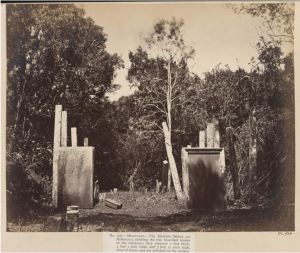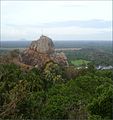OB03161 Mihintaḷē Trikāyastava Inscribed Rock
IN03202 Mihintaḷē Trikāyastava Rock Inscription
This inscription is engraved on the perpendicular face of a rock situated about 40 or 50 yards (35 or 45 m) to the north-east of the Ambastala Dāgäba at Mihintaḷē. The epigraph has been seriously damaged by the action of the weather and possibly also by the destructive attentions of vandals, to the extent that large portions of the writing are now totally effaced and many letters are not very clear. However, with help from Sylvain Lévi, Senarath Paranavitana identified part of the inscription as a copy of the Trikāyastava, a Sanskrit hymn consisting of three Sragdharāverses adoring the three bodies of the Buddha and a fourth verse in the same metre embodying the wish of the reciter. Lévi published a version of the Trikāyastava, restored to Sanskrit from a Chinese transliteration, in 1896, and another version was published by Baron A. von Staël-Holstein from a Tibetan codex in 1911. Neither version was perfect: the Tibetan version was missing the fourth verse and, although the Chinese version was complete, Lévi was unable to recognise certain words due to the fact that the Chinese alphabet does not allow for precise transliteration of Sanskrit. Nonetheless, using these two version together, Paranavitana was able to read the Trikāyastava in the Mihintaḷē inscription, filling in those portions which are missing on the stone. The Trikāyastava starts towards the close of the sixteenth line of the inscription and is continued over the next two and three-quarter lines. The first sixteen lines of the inscription also appear to be in Sanskrit verse and may include other religious hymns. However, the inscription’s poor state of preservation means that none of these verses can be deciphered. Equally difficult to make out are the final lines of the inscription, which contain some verses in the śloka metre. These verses appear to give an account of the person who had the epigraph engraved on the stone and his religious aspirations in doing this meritorious act. His name is not preserved but he seems to have been a monk.
OB03145 Ambasthala Cetiya Flagstone
Ambasthala Dagoba, Mihintale
IN03184 Ambasthala Cetiya Flagstone Inscription
This inscription is engraved on a flagstone in the pavement of the Ambasthala Cetiya at Mihintaḷē. It can be dated on palaeographic grounds to the eighth century A.D. and consists of two lines of unequal length, the first measuring 3 feet 6 inches (106.68 cm) and the second 2 feet 1 inch (63.5 cm). This suggests that the record may be unfinished or that some letters have been effaced at the end of the second line. Due to the incomplete nature of the inscription, its purpose is not clear. In the surviving portion of the record, an individual named Mihindal (Mahinda) states that he salutes the officers in the palace of his king.
OB03104 In̆dikaṭusǟya Copper Plaques
Mihintale, Sri Lanka
IN03128 In̆dikaṭusǟya Copper Plaque Inscriptions
In 1923, ninety-one inscribed copper votive tablets were found among the ruins of the Indikatuseya stupa at Mihintale. The tablets were discovered by the Archaeological Department of Ceylon during the restoration and rebuilding of the dome of the stupa. It appears that they were originally deposited in the relic chamber but became scattered when the stupa was raided by treasure-seekers, which would also explain the presence of some Dutch stivers in amongst the medieval copper tablets. Most of the tablets are about 0.8 mm in thickness and are inscribed on one side only. Some bear traces of gilding. The majority are completely intact but a few are broken or have missing corners. On palaeographic grounds, they can be dated to the eighth or ninth century A.D. The inscriptions on the tablets are extracts from Buddhist texts of the Mahāyāna school. Indeed, forty-six have been connected with specific passages in the Pañcaviṁśati-sāhasrikā Prajñāpāramitā (nos. 1–46). A further fifteen have been found to quote from various passages in the Kāśyapa-parivartta (nos. 47, 48, 50–54, 57, 58, 61, 63, 67, 69, 76 and 79). The language of the inscriptions is Sanskrit but they are written in Sinhalese characters. The tablets are therefore significant epigraphical rarities, since there are few surviving examples from the medieval period that show the transcription of Sanskrit in Sinhalese script. However, the scribe does not appear to have been overly familiar with Sanskrit and, as a result, the inscriptions on the plaques often diverge slightly from their source texts.
OB03025b Mihintale Tablet B
OB03025a Mihintale Tablet A
OB03025 Mihintale Tablets of Mahinda IV

Mihintale. The Bhójana Sáláwa (or Refrectory), showing the two inscribed stones at the entrance. Photographed by Joseph Lawton (d. 1872) active in Sri Lanka between 1866 and 1872. V&A 82756
IN03030 Mihintale Inscription of Mahinda IV
The inscription is written on two granite slabs, which stand near the old refectory, also called Bhōjana-sālā, on the left of the third set of steps (on four) on the western slope of the hill at Mihintale. The inscription is divided equally between the two slabs, each one bearing 58 lines of Sinhalese prose. They were installed by the king Mahinda IV (975-91 A.D.) and record rules and regulations for the administration of the monastery (the name of the monastery is not mentioned) and payments made to the service staff.


